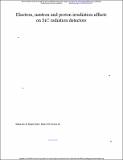Por favor, use este identificador para citar o enlazar a este item:
http://hdl.handle.net/10261/245530COMPARTIR / EXPORTAR:
 SHARE
BASE SHARE
BASE
|
|
| Visualizar otros formatos: MARC | Dublin Core | RDF | ORE | MODS | METS | DIDL | DATACITE | |

| Título: | Electron, Neutron, and Proton Irradiation Effects on SiC Radiation Detectors |
Autor: | Rafí, Joan Marc ; Pellegrini, Giulio CSIC ORCID; Godignon, Philippe; Otero-Ugobono, Sofía; Rius, Gemma CSIC ORCID ; Tsunoda, Isao; Yoneoka, Masashi; Takakura, Kenichiro; Kramberger, Gregor; Moll, Michael | Palabras clave: | Alpha particles Fusion reactors Radiation effects Semiconductor radiation detectors Silicon carbide (SiC). |
Fecha de publicación: | 8-oct-2020 | Editor: | Institute of Electrical and Electronics Engineers | Citación: | IEEE Transactions on Nuclear Science | Resumen: | Owing to their low dark current, high transparency, high thermal conductivity, and potential radiation hardness, there is a special interest in silicon carbide (SiC) devices for radiation monitoring in radiation harsh environments and with elevated temperatures and, especially, for the plasma diagnostic systems in future nuclear fusion reactors. In this work, four-quadrant p-n junction diodes produced on epitaxial 4H-SiC substrates are studied. The impact of electron, neutron, and proton irradiations (up to fluences of 1 × 10 16 electrons (e)/cm 2 , 2 × 10 15 neutrons (n)/cm 2 , and 2.5 × 10 15 protons (p)/cm 2 , respectively) on the electrical characteristics is studied by means of current-voltage (I-V) and capacitance-voltage (C-V) techniques. Regardless of the particle type and applied fluences, the results show similar low reverse currents for irradiated SiC devices, which are at least about four orders of magnitude lower than comparable Si devices. The effects of irradiation on interquadrant resistance and charge build-up in the interquadrant isolation are assessed. Furthermore, device performance as a radiation detector is investigated upon exposure to a collimated 239 Pu- 241 Am- 244 Cm trialpha source. The performance at room temperature is preserved even for the highest irradiation fluences, despite the fact that the rectification character in electrical characteristics is lost. From the results, advantages of using SiC devices in alpha particle detection in harsh environments can be envisaged. | Versión del editor: | https://doi.org/10.1109/TNS.2020.3029730 | URI: | http://hdl.handle.net/10261/245530 | ISSN: | 0018-9499 | E-ISSN: | 1558-1578 |
| Aparece en las colecciones: | (IMB-CNM) Artículos |
Ficheros en este ítem:
| Fichero | Descripción | Tamaño | Formato | |
|---|---|---|---|---|
| TNS3029730_sense_marca_proofs_xo_encara_sense_correccions_finals.pdf | 1,6 MB | Adobe PDF |  Visualizar/Abrir |
CORE Recommender
Page view(s)
120
checked on 22-abr-2024
Download(s)
518
checked on 22-abr-2024
Google ScholarTM
Check
NOTA: Los ítems de Digital.CSIC están protegidos por copyright, con todos los derechos reservados, a menos que se indique lo contrario.
